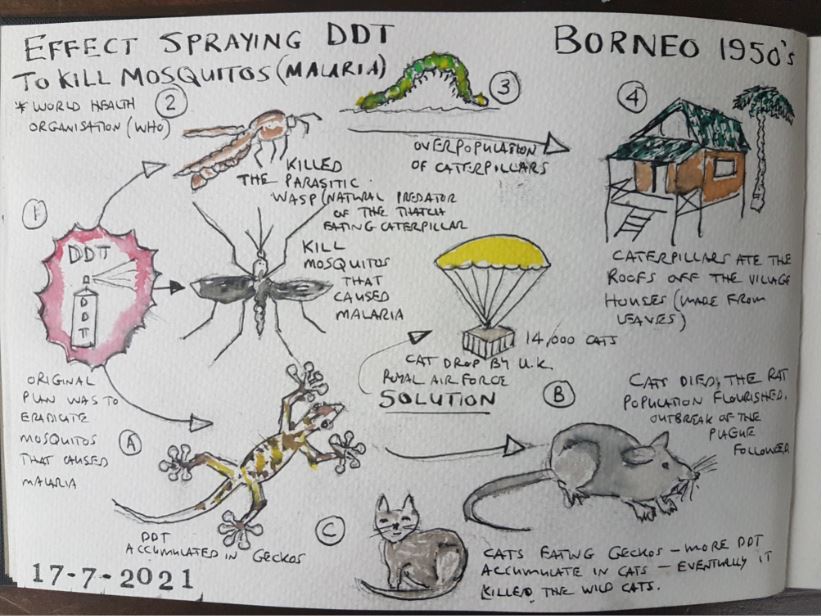SYNOPSIS: The story of Malaria and the spraying of DDT in Borneo – a true story. Sustainability, food chain and eco-system focus.
Reflection and critical thinking:
If you don’t understand the inter-relatedness of things, solutions often cause more problems.
Simple questions often require complex and reflective thinking if reasonable solutions are to be found.
It is always better to manage by design than by default.
Source: Systems thinking: a cautionary tale (cats in Borneo)
Source: https://newomapat.wordpress.com/2015/05/13/operation-cat-drop/
LESSON PLAN AND IDEAS FOR TEACHERS, PARENTS AND HOMESCHOOLERS:
SUSTAINABILITY: This story prompts an excellent lesson plan for teachers: Sustainability, food chains, and ecosystems.
Learning intentions:
- Learn about food chains
- Learn about ecosystems
- Learn about biodiversity
- Learn about the equilibrium and balance in ecosystems
- Learn how to work collaboratively together (in groups). Equal collaboration and contribution
- Compare two case studies: DDT spraying in Borneo and Beaver decline in North America (preventing flooding and improving water quality). Or choose any other cases (historical).
- Learn basic referencing when doing research. Typical APA style. Or include a bibliography. What is the difference between the two?
- Taking action for the environment. Write a letter or make a poster (canva.com). Or, write a short article to a local newspaper. Include some photographs in your article. Consider including a diagram explaining the details (e.g. scientific)
- Develop critical thinking and reflective research skills (compare and contrast the case studies). Type up differences and things that are the same. Use a table (Google Sheets)
- Design and create digital tools to improve or solve an environmental issue or problem (e.g. programming microprocessors, design sensors, develop software and apps). For example, use the Micro:bit sensors and design a simple electronic mechanism. Computer programming and coding.
- Develop Global Citizenship: What is your message to the local community or the world regarding what you have discovered?
- Cultural Responsive and Relational Pedagogy: Design a diagram that portrays the food chain, ecosystem or events in a case study (e.g. dwindling number of beavers in North America – or a local issue in your area). Use a different language for the headings/annotations/tags. For example: Spanish, Maori, Italian, German, Latin, and more. Can you create a simple app to translate? Explore the idea of creating an app (translate). How are apps created?
- PROJECT FOR THE ENVIRONMENT (IN GROUPS): Learn how to address a real-life problem or issue using the new knowledge. Focus on your own area/environment – for example, water quality in New Zealand (Waikato)/overfishing, soil health (excess of acidification) and many more.
After analysing the DDT effect on the island of Borneo, a second case study could be “The decline of beavers in North America.” Beavers have a tremendous role to play in the quality of water. Here is a short introduction to the amazing work that beavers do for our natural habitats: ‘Beavers: Builders of Habitat and Quality Water.’ See the YouTube video below.
Description
*Additional to this article: Don’t miss the great lesson ideas at the end (for teachers, parents, and homeschoolers) – Digital Collaborative Learning.
EXCERPT:
“Rat-a-strophic,” laughed the freight plane dispatcher.
“Or, maybe Cat-o-matics,” chuckled the second dispatcher.
“They are going to get a rude awakening,” said the experienced military veteran.
The tailgate of the aeroplane was open; the officers had to hold on for dear life.
The wind violently pushed and pulled the two officers of the Royal Air Force at the gate of the freight plane – a fleet of camouflaged C130’s from the UK were powering through the cold Borneo air. They resembled massive ‘iron eagles’ entering into Borneo’s airspace. The officers were attached with thin steel cables to the plane. If they fell out and their emergency parachutes took them down to the area below them, they would probably be eaten alive. A large sign covered the sides of the planes: ‘World Health Organisation (WHO) – Operations.’
The rats and mice looked up as the large eagles headed towards them. The forest held its breath.
“What on earth are they up to?” asked Ratatouille.
“I have no idea,” said Ratana.
The eyes of hundreds of predators were blinking nervously in the dim-lit belly of the plane. They were trapped. Trapped in crates. Large paper tags tied to the boxes read:
DESTINATION: Borneo – DATE: July 1956. Approved and Ratified by the WHO? ‘Operation Cat-a-strophic.’
Well, it did not read exactly like that. However, I could not resist adding some fiction to introduce this true story. Take the intro with a little bit of salt. This unique story will get very true – soon.
The crates were tied together in clumps. A giant parachute – wrapped in a camouflaged bag – sat neatly on top of every group of containers. A steel cable was attached to the bag – a static line. The function of the static line is to pull the parachute out of the bag as it exits the aeroplane. The parachute will deploy about 20 to 30 metres below the plane. It would take the predators down – slowly pendulating. It would provide them with an opportunity to see Borneo from ‘outer space.’

The author’s sketchbook: The effect of spraying DDT in the island of Borneo (1950’s). This diagram shows a summary of how the DDT rippled through the environment in Borneo. The initial aim was to eradicate mosquitos which were the carriers of deadly Malaria. W Van Zyl.
An animated overview of the true events:
Read the full article online as a blog post:
https://fivehousepublishing.com/2021/07/19/rat-a-strophics-and-cat-o-matics/
Read the full article online as a blog post:




